Designing a Dementia Friendly Environment for Person-Centered Care
VerifiedAdded on 2023/05/29
|8
|2005
|178
AI Summary
This study emphasizes on designing a dementia friendly environment that will support the person centred care. The study will also compare two videos that are based on the two different of care providing environment to the dementia patients.
Contribute Materials
Your contribution can guide someone’s learning journey. Share your
documents today.

Running head: DEMENTIA ENVIRONMENT
Dementia Environment
Name of the Student:
Name of the University:
Author Note:
Dementia Environment
Name of the Student:
Name of the University:
Author Note:
Secure Best Marks with AI Grader
Need help grading? Try our AI Grader for instant feedback on your assignments.
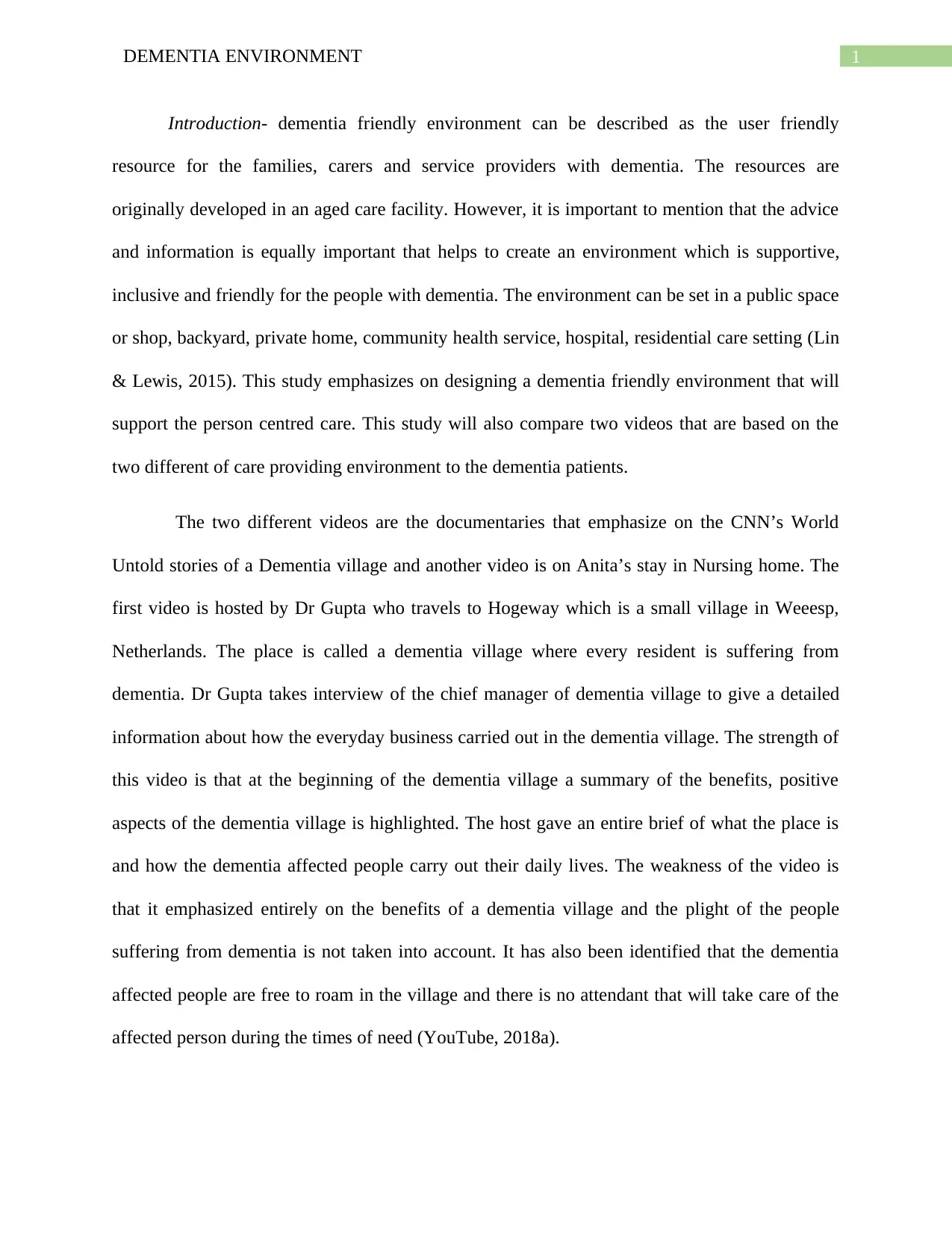
1DEMENTIA ENVIRONMENT
Introduction- dementia friendly environment can be described as the user friendly
resource for the families, carers and service providers with dementia. The resources are
originally developed in an aged care facility. However, it is important to mention that the advice
and information is equally important that helps to create an environment which is supportive,
inclusive and friendly for the people with dementia. The environment can be set in a public space
or shop, backyard, private home, community health service, hospital, residential care setting (Lin
& Lewis, 2015). This study emphasizes on designing a dementia friendly environment that will
support the person centred care. This study will also compare two videos that are based on the
two different of care providing environment to the dementia patients.
The two different videos are the documentaries that emphasize on the CNN’s World
Untold stories of a Dementia village and another video is on Anita’s stay in Nursing home. The
first video is hosted by Dr Gupta who travels to Hogeway which is a small village in Weeesp,
Netherlands. The place is called a dementia village where every resident is suffering from
dementia. Dr Gupta takes interview of the chief manager of dementia village to give a detailed
information about how the everyday business carried out in the dementia village. The strength of
this video is that at the beginning of the dementia village a summary of the benefits, positive
aspects of the dementia village is highlighted. The host gave an entire brief of what the place is
and how the dementia affected people carry out their daily lives. The weakness of the video is
that it emphasized entirely on the benefits of a dementia village and the plight of the people
suffering from dementia is not taken into account. It has also been identified that the dementia
affected people are free to roam in the village and there is no attendant that will take care of the
affected person during the times of need (YouTube, 2018a).
Introduction- dementia friendly environment can be described as the user friendly
resource for the families, carers and service providers with dementia. The resources are
originally developed in an aged care facility. However, it is important to mention that the advice
and information is equally important that helps to create an environment which is supportive,
inclusive and friendly for the people with dementia. The environment can be set in a public space
or shop, backyard, private home, community health service, hospital, residential care setting (Lin
& Lewis, 2015). This study emphasizes on designing a dementia friendly environment that will
support the person centred care. This study will also compare two videos that are based on the
two different of care providing environment to the dementia patients.
The two different videos are the documentaries that emphasize on the CNN’s World
Untold stories of a Dementia village and another video is on Anita’s stay in Nursing home. The
first video is hosted by Dr Gupta who travels to Hogeway which is a small village in Weeesp,
Netherlands. The place is called a dementia village where every resident is suffering from
dementia. Dr Gupta takes interview of the chief manager of dementia village to give a detailed
information about how the everyday business carried out in the dementia village. The strength of
this video is that at the beginning of the dementia village a summary of the benefits, positive
aspects of the dementia village is highlighted. The host gave an entire brief of what the place is
and how the dementia affected people carry out their daily lives. The weakness of the video is
that it emphasized entirely on the benefits of a dementia village and the plight of the people
suffering from dementia is not taken into account. It has also been identified that the dementia
affected people are free to roam in the village and there is no attendant that will take care of the
affected person during the times of need (YouTube, 2018a).
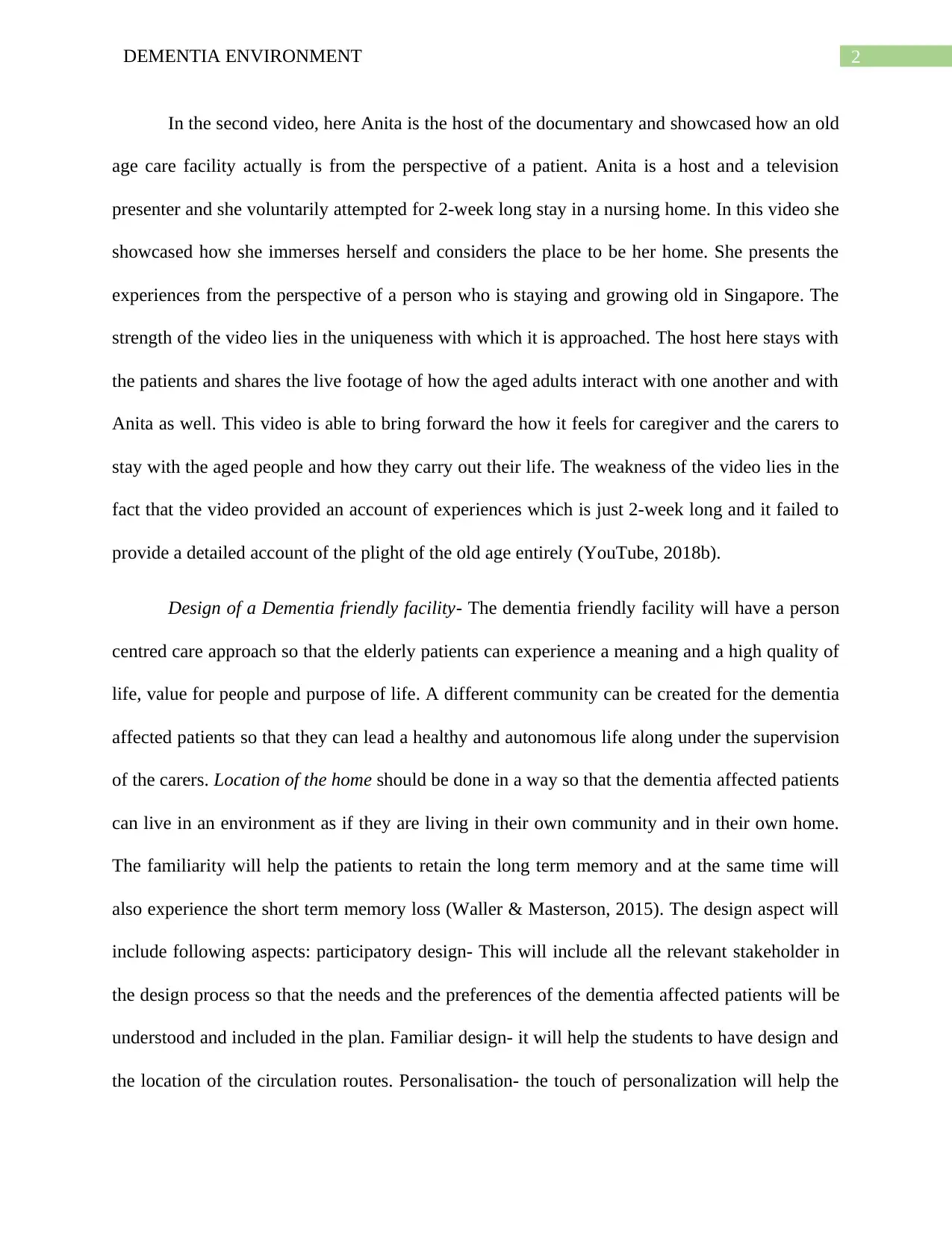
2DEMENTIA ENVIRONMENT
In the second video, here Anita is the host of the documentary and showcased how an old
age care facility actually is from the perspective of a patient. Anita is a host and a television
presenter and she voluntarily attempted for 2-week long stay in a nursing home. In this video she
showcased how she immerses herself and considers the place to be her home. She presents the
experiences from the perspective of a person who is staying and growing old in Singapore. The
strength of the video lies in the uniqueness with which it is approached. The host here stays with
the patients and shares the live footage of how the aged adults interact with one another and with
Anita as well. This video is able to bring forward the how it feels for caregiver and the carers to
stay with the aged people and how they carry out their life. The weakness of the video lies in the
fact that the video provided an account of experiences which is just 2-week long and it failed to
provide a detailed account of the plight of the old age entirely (YouTube, 2018b).
Design of a Dementia friendly facility- The dementia friendly facility will have a person
centred care approach so that the elderly patients can experience a meaning and a high quality of
life, value for people and purpose of life. A different community can be created for the dementia
affected patients so that they can lead a healthy and autonomous life along under the supervision
of the carers. Location of the home should be done in a way so that the dementia affected patients
can live in an environment as if they are living in their own community and in their own home.
The familiarity will help the patients to retain the long term memory and at the same time will
also experience the short term memory loss (Waller & Masterson, 2015). The design aspect will
include following aspects: participatory design- This will include all the relevant stakeholder in
the design process so that the needs and the preferences of the dementia affected patients will be
understood and included in the plan. Familiar design- it will help the students to have design and
the location of the circulation routes. Personalisation- the touch of personalization will help the
In the second video, here Anita is the host of the documentary and showcased how an old
age care facility actually is from the perspective of a patient. Anita is a host and a television
presenter and she voluntarily attempted for 2-week long stay in a nursing home. In this video she
showcased how she immerses herself and considers the place to be her home. She presents the
experiences from the perspective of a person who is staying and growing old in Singapore. The
strength of the video lies in the uniqueness with which it is approached. The host here stays with
the patients and shares the live footage of how the aged adults interact with one another and with
Anita as well. This video is able to bring forward the how it feels for caregiver and the carers to
stay with the aged people and how they carry out their life. The weakness of the video lies in the
fact that the video provided an account of experiences which is just 2-week long and it failed to
provide a detailed account of the plight of the old age entirely (YouTube, 2018b).
Design of a Dementia friendly facility- The dementia friendly facility will have a person
centred care approach so that the elderly patients can experience a meaning and a high quality of
life, value for people and purpose of life. A different community can be created for the dementia
affected patients so that they can lead a healthy and autonomous life along under the supervision
of the carers. Location of the home should be done in a way so that the dementia affected patients
can live in an environment as if they are living in their own community and in their own home.
The familiarity will help the patients to retain the long term memory and at the same time will
also experience the short term memory loss (Waller & Masterson, 2015). The design aspect will
include following aspects: participatory design- This will include all the relevant stakeholder in
the design process so that the needs and the preferences of the dementia affected patients will be
understood and included in the plan. Familiar design- it will help the students to have design and
the location of the circulation routes. Personalisation- the touch of personalization will help the
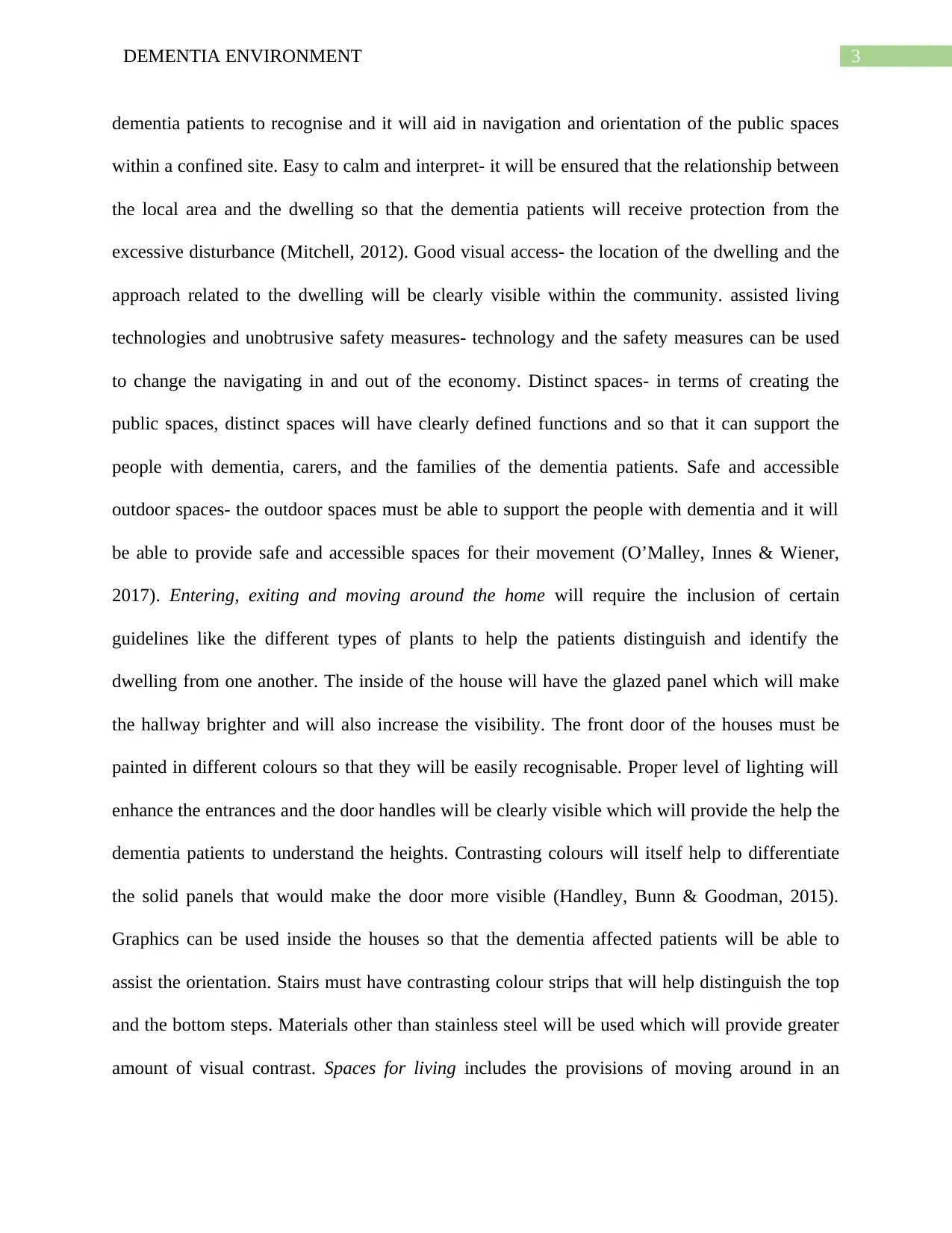
3DEMENTIA ENVIRONMENT
dementia patients to recognise and it will aid in navigation and orientation of the public spaces
within a confined site. Easy to calm and interpret- it will be ensured that the relationship between
the local area and the dwelling so that the dementia patients will receive protection from the
excessive disturbance (Mitchell, 2012). Good visual access- the location of the dwelling and the
approach related to the dwelling will be clearly visible within the community. assisted living
technologies and unobtrusive safety measures- technology and the safety measures can be used
to change the navigating in and out of the economy. Distinct spaces- in terms of creating the
public spaces, distinct spaces will have clearly defined functions and so that it can support the
people with dementia, carers, and the families of the dementia patients. Safe and accessible
outdoor spaces- the outdoor spaces must be able to support the people with dementia and it will
be able to provide safe and accessible spaces for their movement (O’Malley, Innes & Wiener,
2017). Entering, exiting and moving around the home will require the inclusion of certain
guidelines like the different types of plants to help the patients distinguish and identify the
dwelling from one another. The inside of the house will have the glazed panel which will make
the hallway brighter and will also increase the visibility. The front door of the houses must be
painted in different colours so that they will be easily recognisable. Proper level of lighting will
enhance the entrances and the door handles will be clearly visible which will provide the help the
dementia patients to understand the heights. Contrasting colours will itself help to differentiate
the solid panels that would make the door more visible (Handley, Bunn & Goodman, 2015).
Graphics can be used inside the houses so that the dementia affected patients will be able to
assist the orientation. Stairs must have contrasting colour strips that will help distinguish the top
and the bottom steps. Materials other than stainless steel will be used which will provide greater
amount of visual contrast. Spaces for living includes the provisions of moving around in an
dementia patients to recognise and it will aid in navigation and orientation of the public spaces
within a confined site. Easy to calm and interpret- it will be ensured that the relationship between
the local area and the dwelling so that the dementia patients will receive protection from the
excessive disturbance (Mitchell, 2012). Good visual access- the location of the dwelling and the
approach related to the dwelling will be clearly visible within the community. assisted living
technologies and unobtrusive safety measures- technology and the safety measures can be used
to change the navigating in and out of the economy. Distinct spaces- in terms of creating the
public spaces, distinct spaces will have clearly defined functions and so that it can support the
people with dementia, carers, and the families of the dementia patients. Safe and accessible
outdoor spaces- the outdoor spaces must be able to support the people with dementia and it will
be able to provide safe and accessible spaces for their movement (O’Malley, Innes & Wiener,
2017). Entering, exiting and moving around the home will require the inclusion of certain
guidelines like the different types of plants to help the patients distinguish and identify the
dwelling from one another. The inside of the house will have the glazed panel which will make
the hallway brighter and will also increase the visibility. The front door of the houses must be
painted in different colours so that they will be easily recognisable. Proper level of lighting will
enhance the entrances and the door handles will be clearly visible which will provide the help the
dementia patients to understand the heights. Contrasting colours will itself help to differentiate
the solid panels that would make the door more visible (Handley, Bunn & Goodman, 2015).
Graphics can be used inside the houses so that the dementia affected patients will be able to
assist the orientation. Stairs must have contrasting colour strips that will help distinguish the top
and the bottom steps. Materials other than stainless steel will be used which will provide greater
amount of visual contrast. Spaces for living includes the provisions of moving around in an
Secure Best Marks with AI Grader
Need help grading? Try our AI Grader for instant feedback on your assignments.
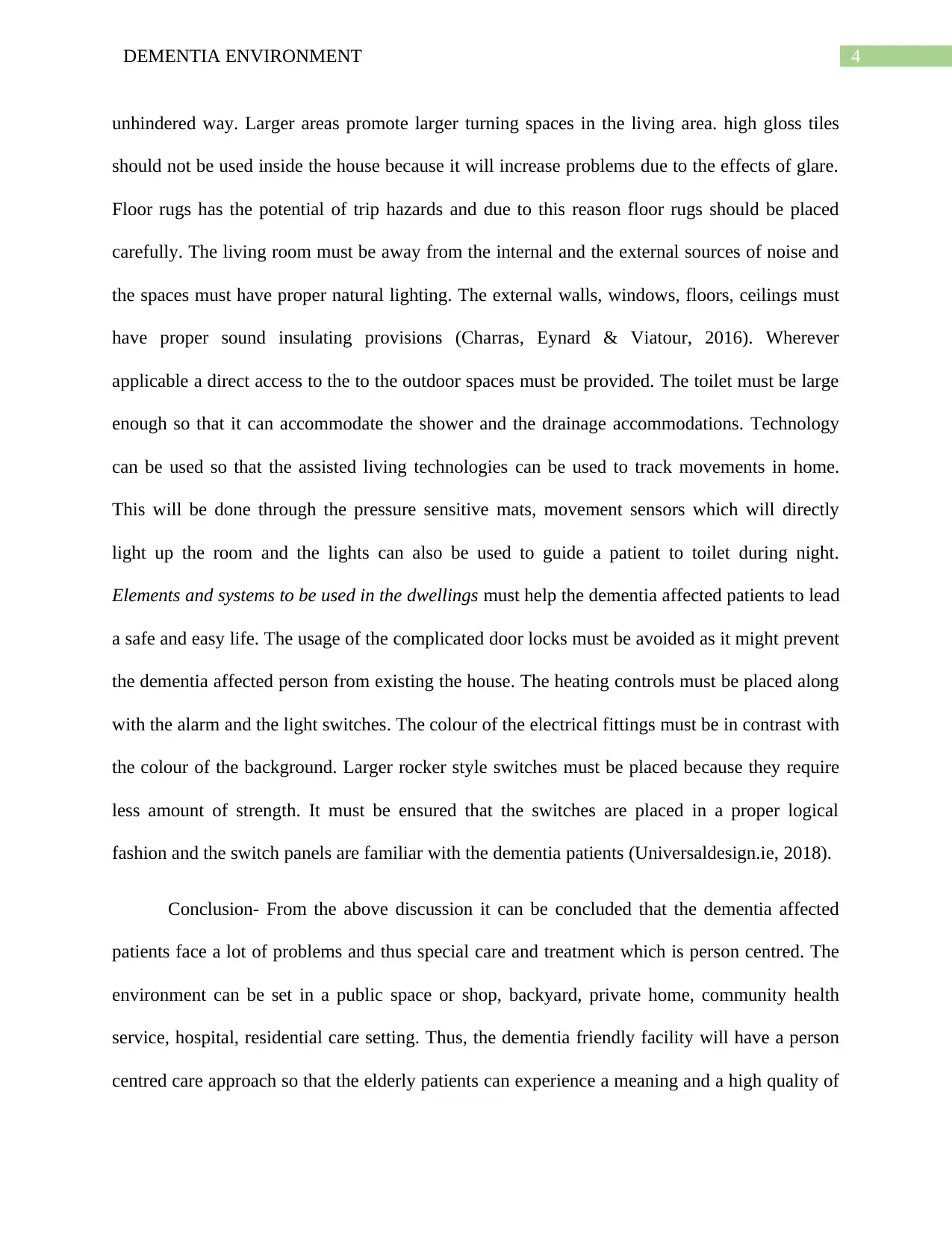
4DEMENTIA ENVIRONMENT
unhindered way. Larger areas promote larger turning spaces in the living area. high gloss tiles
should not be used inside the house because it will increase problems due to the effects of glare.
Floor rugs has the potential of trip hazards and due to this reason floor rugs should be placed
carefully. The living room must be away from the internal and the external sources of noise and
the spaces must have proper natural lighting. The external walls, windows, floors, ceilings must
have proper sound insulating provisions (Charras, Eynard & Viatour, 2016). Wherever
applicable a direct access to the to the outdoor spaces must be provided. The toilet must be large
enough so that it can accommodate the shower and the drainage accommodations. Technology
can be used so that the assisted living technologies can be used to track movements in home.
This will be done through the pressure sensitive mats, movement sensors which will directly
light up the room and the lights can also be used to guide a patient to toilet during night.
Elements and systems to be used in the dwellings must help the dementia affected patients to lead
a safe and easy life. The usage of the complicated door locks must be avoided as it might prevent
the dementia affected person from existing the house. The heating controls must be placed along
with the alarm and the light switches. The colour of the electrical fittings must be in contrast with
the colour of the background. Larger rocker style switches must be placed because they require
less amount of strength. It must be ensured that the switches are placed in a proper logical
fashion and the switch panels are familiar with the dementia patients (Universaldesign.ie, 2018).
Conclusion- From the above discussion it can be concluded that the dementia affected
patients face a lot of problems and thus special care and treatment which is person centred. The
environment can be set in a public space or shop, backyard, private home, community health
service, hospital, residential care setting. Thus, the dementia friendly facility will have a person
centred care approach so that the elderly patients can experience a meaning and a high quality of
unhindered way. Larger areas promote larger turning spaces in the living area. high gloss tiles
should not be used inside the house because it will increase problems due to the effects of glare.
Floor rugs has the potential of trip hazards and due to this reason floor rugs should be placed
carefully. The living room must be away from the internal and the external sources of noise and
the spaces must have proper natural lighting. The external walls, windows, floors, ceilings must
have proper sound insulating provisions (Charras, Eynard & Viatour, 2016). Wherever
applicable a direct access to the to the outdoor spaces must be provided. The toilet must be large
enough so that it can accommodate the shower and the drainage accommodations. Technology
can be used so that the assisted living technologies can be used to track movements in home.
This will be done through the pressure sensitive mats, movement sensors which will directly
light up the room and the lights can also be used to guide a patient to toilet during night.
Elements and systems to be used in the dwellings must help the dementia affected patients to lead
a safe and easy life. The usage of the complicated door locks must be avoided as it might prevent
the dementia affected person from existing the house. The heating controls must be placed along
with the alarm and the light switches. The colour of the electrical fittings must be in contrast with
the colour of the background. Larger rocker style switches must be placed because they require
less amount of strength. It must be ensured that the switches are placed in a proper logical
fashion and the switch panels are familiar with the dementia patients (Universaldesign.ie, 2018).
Conclusion- From the above discussion it can be concluded that the dementia affected
patients face a lot of problems and thus special care and treatment which is person centred. The
environment can be set in a public space or shop, backyard, private home, community health
service, hospital, residential care setting. Thus, the dementia friendly facility will have a person
centred care approach so that the elderly patients can experience a meaning and a high quality of
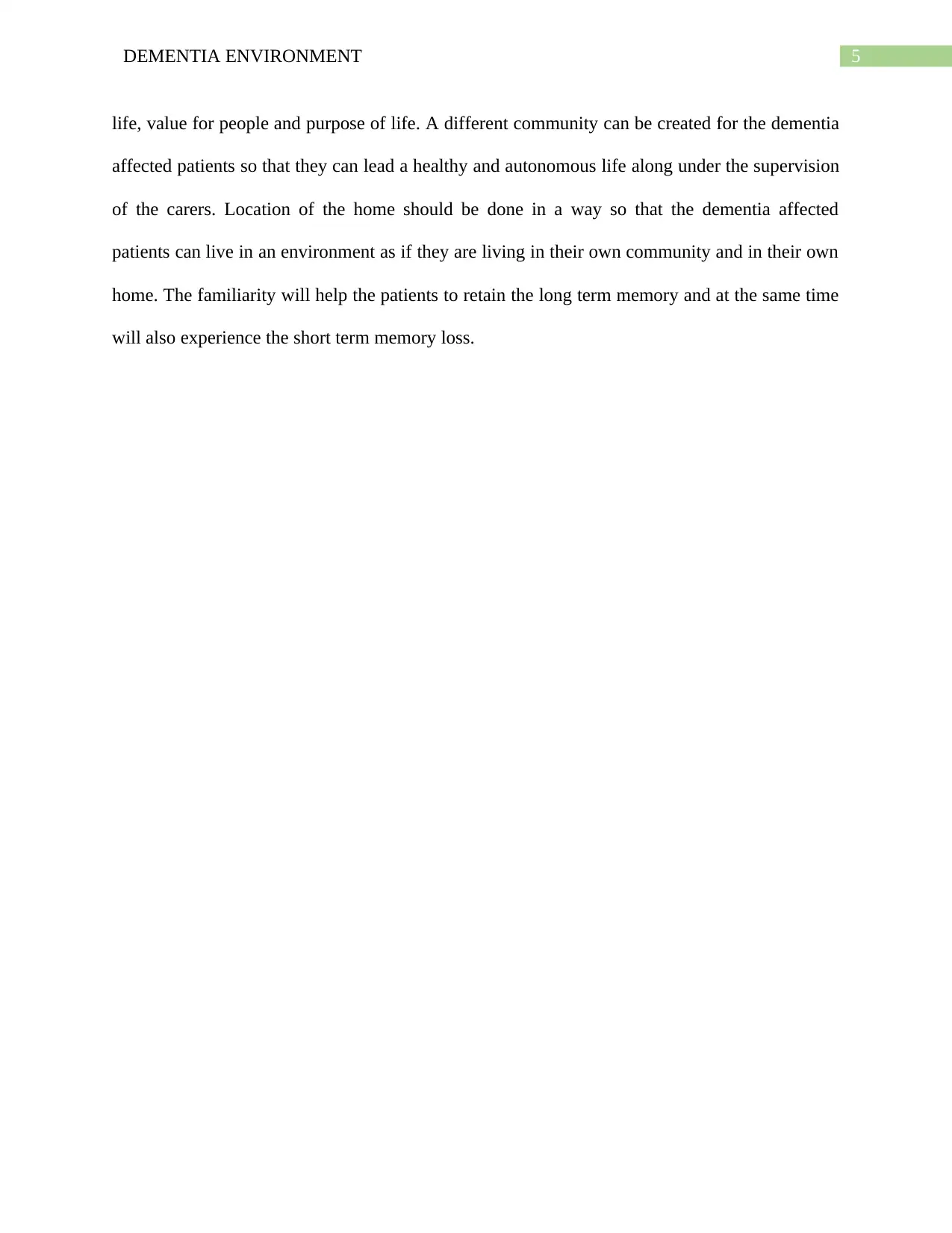
5DEMENTIA ENVIRONMENT
life, value for people and purpose of life. A different community can be created for the dementia
affected patients so that they can lead a healthy and autonomous life along under the supervision
of the carers. Location of the home should be done in a way so that the dementia affected
patients can live in an environment as if they are living in their own community and in their own
home. The familiarity will help the patients to retain the long term memory and at the same time
will also experience the short term memory loss.
life, value for people and purpose of life. A different community can be created for the dementia
affected patients so that they can lead a healthy and autonomous life along under the supervision
of the carers. Location of the home should be done in a way so that the dementia affected
patients can live in an environment as if they are living in their own community and in their own
home. The familiarity will help the patients to retain the long term memory and at the same time
will also experience the short term memory loss.
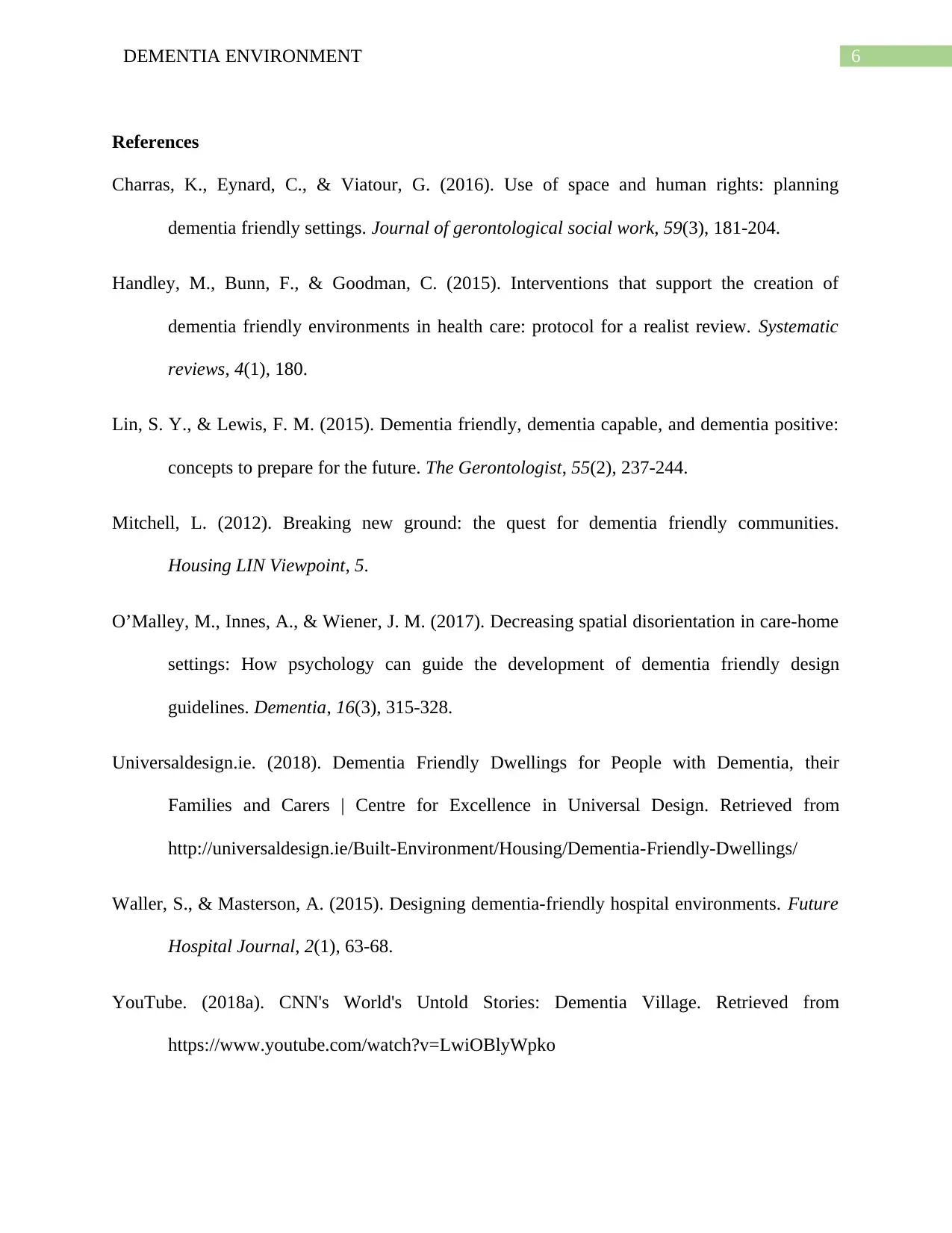
6DEMENTIA ENVIRONMENT
References
Charras, K., Eynard, C., & Viatour, G. (2016). Use of space and human rights: planning
dementia friendly settings. Journal of gerontological social work, 59(3), 181-204.
Handley, M., Bunn, F., & Goodman, C. (2015). Interventions that support the creation of
dementia friendly environments in health care: protocol for a realist review. Systematic
reviews, 4(1), 180.
Lin, S. Y., & Lewis, F. M. (2015). Dementia friendly, dementia capable, and dementia positive:
concepts to prepare for the future. The Gerontologist, 55(2), 237-244.
Mitchell, L. (2012). Breaking new ground: the quest for dementia friendly communities.
Housing LIN Viewpoint, 5.
O’Malley, M., Innes, A., & Wiener, J. M. (2017). Decreasing spatial disorientation in care-home
settings: How psychology can guide the development of dementia friendly design
guidelines. Dementia, 16(3), 315-328.
Universaldesign.ie. (2018). Dementia Friendly Dwellings for People with Dementia, their
Families and Carers | Centre for Excellence in Universal Design. Retrieved from
http://universaldesign.ie/Built-Environment/Housing/Dementia-Friendly-Dwellings/
Waller, S., & Masterson, A. (2015). Designing dementia-friendly hospital environments. Future
Hospital Journal, 2(1), 63-68.
YouTube. (2018a). CNN's World's Untold Stories: Dementia Village. Retrieved from
https://www.youtube.com/watch?v=LwiOBlyWpko
References
Charras, K., Eynard, C., & Viatour, G. (2016). Use of space and human rights: planning
dementia friendly settings. Journal of gerontological social work, 59(3), 181-204.
Handley, M., Bunn, F., & Goodman, C. (2015). Interventions that support the creation of
dementia friendly environments in health care: protocol for a realist review. Systematic
reviews, 4(1), 180.
Lin, S. Y., & Lewis, F. M. (2015). Dementia friendly, dementia capable, and dementia positive:
concepts to prepare for the future. The Gerontologist, 55(2), 237-244.
Mitchell, L. (2012). Breaking new ground: the quest for dementia friendly communities.
Housing LIN Viewpoint, 5.
O’Malley, M., Innes, A., & Wiener, J. M. (2017). Decreasing spatial disorientation in care-home
settings: How psychology can guide the development of dementia friendly design
guidelines. Dementia, 16(3), 315-328.
Universaldesign.ie. (2018). Dementia Friendly Dwellings for People with Dementia, their
Families and Carers | Centre for Excellence in Universal Design. Retrieved from
http://universaldesign.ie/Built-Environment/Housing/Dementia-Friendly-Dwellings/
Waller, S., & Masterson, A. (2015). Designing dementia-friendly hospital environments. Future
Hospital Journal, 2(1), 63-68.
YouTube. (2018a). CNN's World's Untold Stories: Dementia Village. Retrieved from
https://www.youtube.com/watch?v=LwiOBlyWpko
Paraphrase This Document
Need a fresh take? Get an instant paraphrase of this document with our AI Paraphraser

7DEMENTIA ENVIRONMENT
YouTube. (2018b). Anita's Nursing Home Stay. Retrieved from
https://www.youtube.com/watch?v=PRemfpdpaQU
YouTube. (2018b). Anita's Nursing Home Stay. Retrieved from
https://www.youtube.com/watch?v=PRemfpdpaQU
1 out of 8
Related Documents
Your All-in-One AI-Powered Toolkit for Academic Success.
+13062052269
info@desklib.com
Available 24*7 on WhatsApp / Email
![[object Object]](/_next/static/media/star-bottom.7253800d.svg)
Unlock your academic potential
© 2024 | Zucol Services PVT LTD | All rights reserved.





